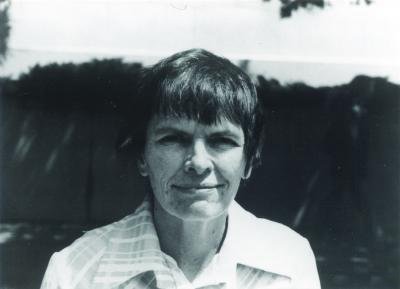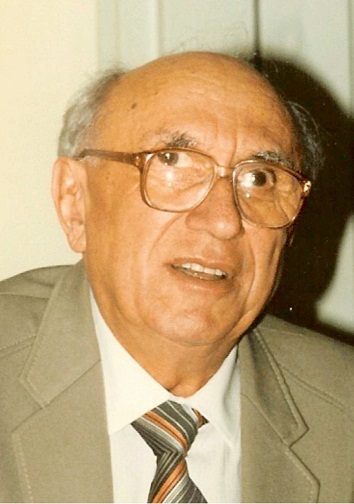<Back to Index>
- Mathematician Julia Hall Bowman Robinson, 1919
- Mathematician Boris Avraamovich Trakhtenbrot, 1921
PAGE SPONSOR

Julia Hall Bowman Robinson (December 8, 1919 – July 30, 1985) was an American mathematician best known for her work on decision problems and Hilbert's Tenth Problem.
Robinson was born in St. Louis, Missouri, the daughter of Ralph Bowers Bowman and Helen (Hall) Bowman. Her older sister was the mathematical popularizer and biographer Constance Reid. The family moved to Arizona and then to San Diego when the girls were a few years old. Julia attended San Diego High.
She entered San Diego State University in 1936 and transferred as a senior to University of California, Berkeley, in 1939. She received her BA degree in 1940 and continued in graduate studies. She received the Ph.D. degree in 1948 under Alfred Tarski with a dissertation on "Definability and Decision Problems in Arithmetic".
In 1975 she became a full professor at Berkeley, teaching quarter - time
because she still did not feel strong enough for a full time job.
Hilbert's tenth problem asks for an algorithm to determine whether a Diophantine equation has any solutions in integers. A series of results developed in the 1940s through 1970 by Robinson, Martin Davis, Hilary Putnam and Yuri Matiyasevich resolved this problem in the negative; that is, they showed that no such algorithm can exist.
George Csicsery produced and directed a one hour documentary about Robinson titled Julia Robinson and Hilbert's Tenth Problem, that premiered at the Joint Mathematics Meeting in San Diego on January 7, 2008. Notices of the American Mathematical Society printed a film review and an interview with the director. College Mathematics Journal also published a film review.
Her Ph.D. thesis was on "Definability and Decision Problems in Arithmetic". In it she showed that the theory of the rational numbers was undecidable by showing that elementary number theory could be defined in terms of the rationals, and elementary number theory was already known to be undecidable (this is Gödel's first Incompleteness Theorem).
Robinson's work only strayed from decision problems twice. The first time was her first paper, published in 1948, on sequential analysis in statistics. The second was a 1951 paper in game theory where she proved that the fictitious play dynamics converges to the mixed strategy Nash equilibrium in two - player zero - sum games. This was posed as a prize problem at RAND with a $200 prize, but she did not receive the prize because she was a RAND employee at the time.
Robinson was attracted to politics by the 1952 presidential campaign of Adlai Stevenson. (Stevenson was her husband's first cousin, but it was his ideas that attracted her and not the family connection.) In the 1950s Robinson was active in local Democratic party activities and did less mathematics. She stuffed envelopes, rang doorbells, asked for votes, and so on. She was Alan Cranston's campaign manager in Contra Costa County when he ran for his first political office, state controller.
Robinson's heart had been damaged by rheumatic fever as a child, and as an adult she suffered poor health and shortness of breath. She married Berkeley professor Raphael Robinson in 1941. In 1961 she underwent an operation to remove the scar tissue from her mitral valve. The operation was a success and she became much more active physically and took up bicycling for exercise. In 1984 she was diagnosed with leukemia. She underwent treatment and went into remission for a few months, but then the disease recurred and she died in Oakland, California, on July 30, 1985.
- United States National Academy of Sciences elected 1975 (first woman mathematician elected)
- Noether Lecturer 1982
- MacArthur Fellowship 1983
- President of American Mathematical Society 1983 – 1984 (first woman president)
- The Julia Robinson Mathematics Festival sponsored by the Mathematical Sciences Research Institute, 2007 - present, was named in her honor.

Boris (Boaz) Avraamovich Trakhtenbrot (Russian: Борис Авраамович Трахтенброт; February 19, 1921, in Brichevo (Romanian: Briceni), northern Bessarabia - September 19, 2016) or Boaz (Boris) Trakhtenbrot (Hebrew: בועז טרכטנברוט) was an Israeli and Russian mathematician in mathematical logic, algorithms, theory of computation and cybernetics. He worked at Akademgorodok, Novosibirsk, during the 1960s and 1970s. He later became a professor in the faculty of Exact sciences of the Tel Aviv University.
In 1964 Trakhtenbrot discovered and proved a fundamental result in Theoretical Computer Science called the Gap theorem. He also discovered and proved what is now called Trakhtenbrot's Theorem which is a theorem in Logic, Model Theory and Computability Theory.